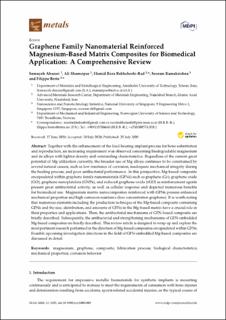| dc.contributor.author | Abazari, Somayeh | |
| dc.contributor.author | Shamsipur, Ali | |
| dc.contributor.author | Bakhsheshi-Rad, Hamid Reza | |
| dc.contributor.author | Ramakrishna, Seeram | |
| dc.contributor.author | Berto, Filippo | |
| dc.date.accessioned | 2022-05-03T13:44:30Z | |
| dc.date.available | 2022-05-03T13:44:30Z | |
| dc.date.created | 2020-12-02T15:01:39Z | |
| dc.date.issued | 2020 | |
| dc.identifier.citation | Metals. 2020, 10 (8), 1-40. | en_US |
| dc.identifier.issn | 2075-4701 | |
| dc.identifier.uri | https://hdl.handle.net/11250/2993984 | |
| dc.description.abstract | Together with the enhancement of the load-bearing implant process for bone substitution and reproduction, an increasing requirement was observed concerning biodegradable magnesium and its alloys with lighter density and outstanding characteristics. Regardless of the current great potential of Mg utilization currently, the broader use of Mg alloys continues to be constrained by several natural causes, such as low resistance of corrosion, inadequate mechanical integrity during the healing process, and poor antibacterial performance. In this perspective, Mg-based composite encapsulated within graphene family nanomaterials (GFNs) such as graphene (Gr), graphene oxide (GO), graphene nanoplatelets (GNPs), and reduced graphene oxide (rGO) as reinforcement agents present great antibacterial activity, as well as cellular response and depicted numerous benefits for biomedical use. Magnesium matrix nanocomposites reinforced with GFNs possess enhanced mechanical properties and high corrosion resistance (low concentration graphene). It is worth noting that numerous elements including the production technique of the Mg-based composite containing GFNs and the size, distribution, and amounts of GFNs in the Mg-based matrix have a crucial role in their properties and applications. Then, the antibacterial mechanisms of GFN-based composite are briefly described. Subsequently, the antibacterial and strengthening mechanisms of GFN-embedded Mg-based composites are briefly described. This review article is designed to wrap up and explore the most pertinent research performed in the direction of Mg-based composites encapsulated within GFNs. Feasible upcoming investigation directions in the field of GFN-embedded Mg-based composites are discussed in detail. | en_US |
| dc.language.iso | eng | en_US |
| dc.publisher | MDPI | en_US |
| dc.rights | Navngivelse 4.0 Internasjonal | * |
| dc.rights.uri | http://creativecommons.org/licenses/by/4.0/deed.no | * |
| dc.title | Graphene Family Nanomaterial Reinforced Magnesium-Based Matrix Composites for Biomedical Application: A Comprehensive Review | en_US |
| dc.title.alternative | Graphene Family Nanomaterial Reinforced Magnesium-Based Matrix Composites for Biomedical Application: A Comprehensive Review | en_US |
| dc.type | Peer reviewed | en_US |
| dc.type | Journal article | en_US |
| dc.description.version | publishedVersion | en_US |
| dc.source.pagenumber | 1-40 | en_US |
| dc.source.volume | 10 | en_US |
| dc.source.journal | Metals | en_US |
| dc.source.issue | 8 | en_US |
| dc.identifier.doi | 10.3390/met10081002 | |
| dc.identifier.cristin | 1855424 | |
| cristin.ispublished | true | |
| cristin.fulltext | original | |
| cristin.qualitycode | 1 | |

